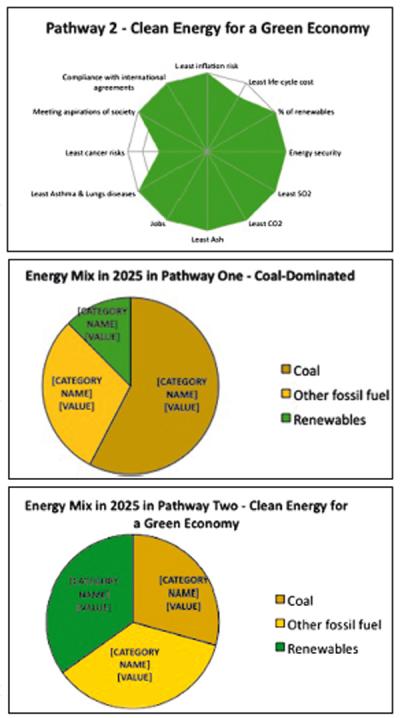Extraits principaux de la partie du rapport de la National Energy Commission (NEC) intitulée « Fostering a Sustainable Energy Future: moving towards a “Green Economy
Persisting with a coal-dominated energy pathway will lock the country into an everlasting coal energy future, with negative impacts in terms of pollution, health hazards and dependency on costly fuel imports. Also, the diversity of concerns and potential of all the islands of the Republic will not be addressed, and the MID target of 35% electricity generated from RE by 2025 will not be met.
Instead another pathway is possible, which reconciles environmental and health concerns with economic priorities (Pathway Two). With the unprecedented reduction in cost as well as rapid technological development taking place in the field of renewable energy, Mauritius can capitalise on its abundance of solar and marine renewable energy and open up a new economic space full of growth potential. This MID-compliant pathway and its numerous benefits (renewables, national effort to reduce demand, role of small planters, SMEs and cooperatives) will not only meet all the socio-economic objectives of Government but also launch a ‘Green Economy’, which has as main features inclusiveness and democratisation of the economy. The emergence of a Clean Energy sector will help bring the Republic of Mauritius to another development level, with strong opportunities to expand in the African region.
The NEC therefore recommends the revisiting of the IEP [“Integrated Electricity Plan”, le plan strategies du CEB pour 2013-2022 to implement Pathway Two and its compliance with, and relevance to, the MID paradigm in an inclusive and participatory manner.
Giving Mauritius a sustainable energy future will not only benefit us, it will be the gift of a prosperous future to forthcoming generations.
[…]
The energy future of Mauritius is facing two radically different pathways:
1. A coal-dominated pathway, with a 100 MW coal-only plant to be followed afterwards by additional coal power plants, based on a least financial cost approach only (Pathway One).
2. A MID-compliant pathway that would satisfy economic affordability, on top of environmental and social sustainability concerns (Pathway Two).
The present configuration of the electricity sector is poised in between these two energy pathways (see Appendix 9 for current supply options). The right choice therefore needs to be made as to the energy future of the country.
The IEP considers that additional power capacity of 200 MW is to be added by 2022. But this is according to a business-as-usual scenario. This figure does not stand if Mauritius embarks on the paradigm shift of MID and moves towards a Green Economy.
[The NEC has estimated] the least-cost option of both pathways – coal-dominated and MID-compliant –from a holistic perspective, which includes the full economic, social and environmental impacts, and not just from strictly the financial perspective. For instance, the competitiveness in our major export markets is not only due to “bottom-line” aspects but is also tributary to issues such as carbon footprint, environmental protection and social norms. Also, health considerations are at the very heart of the concerns of populations. Finally, international donor/lenders more and more require the ‘greening’ of projects before engaging in their financing.
Rapport NEC : bond économique pour le pays si on évite le charbon au profit des énergies renouvelables
- Publicité -
EN CONTINU ↻


